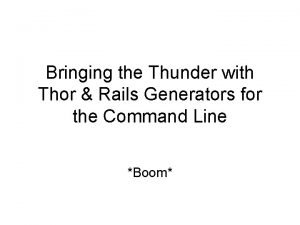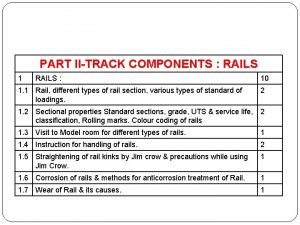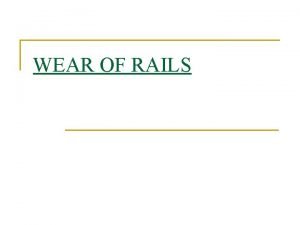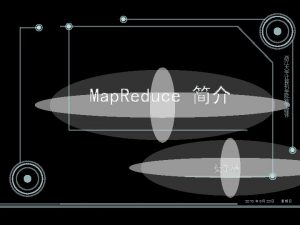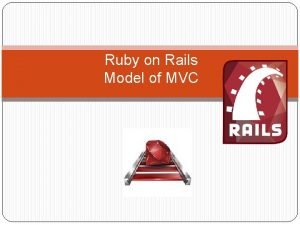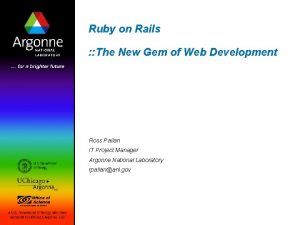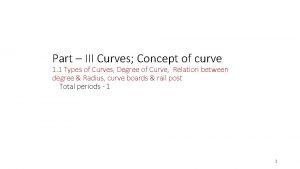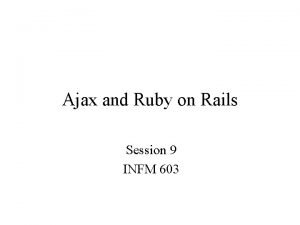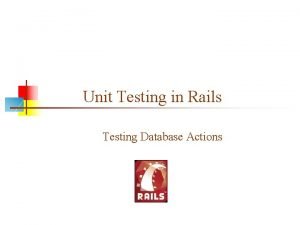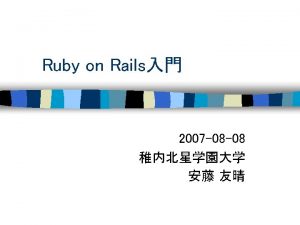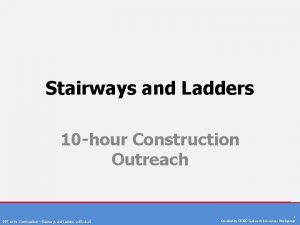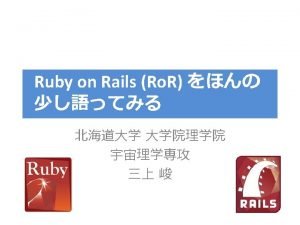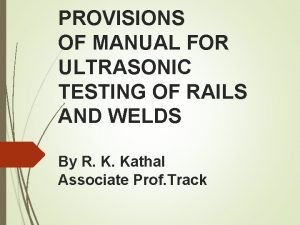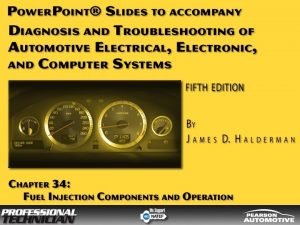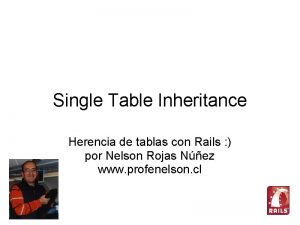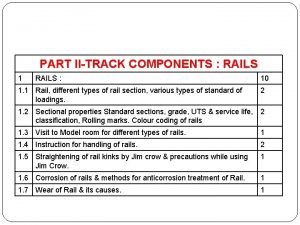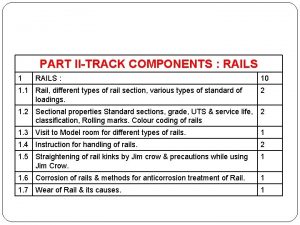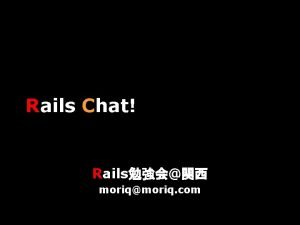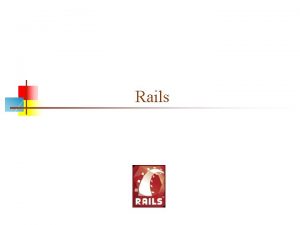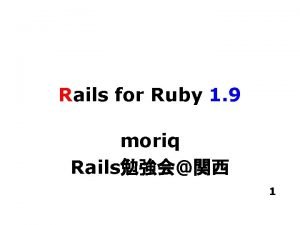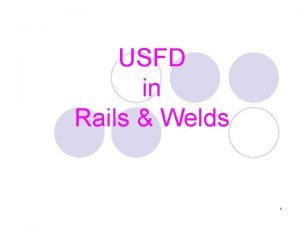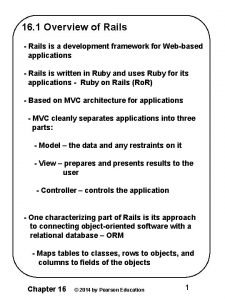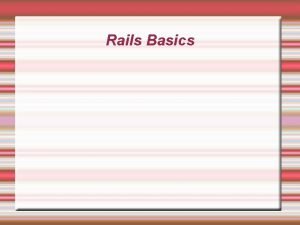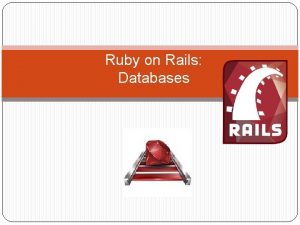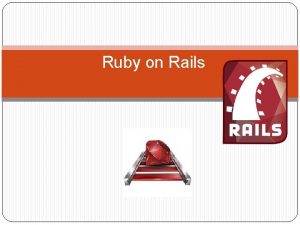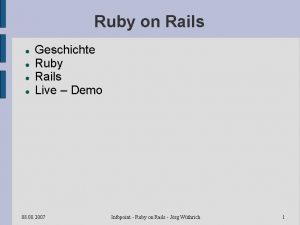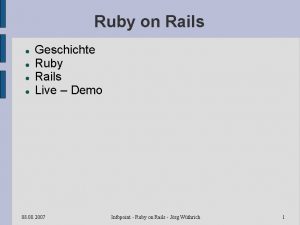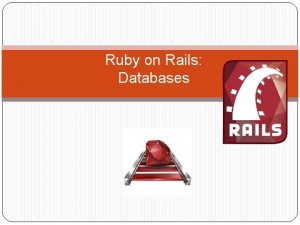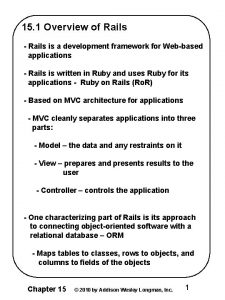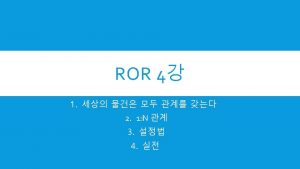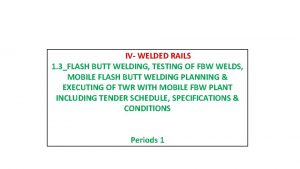PART IITRACK COMPONENTS RAILS 1 RAILS 10 1

























- Slides: 25

PART II-TRACK COMPONENTS : RAILS 1 RAILS : 10 1. 1 Rail, different types of rail section, various types of standard of loadings. 2 1. 2 Sectional properties Standard sections, grade, UTS & service life, classification, Rolling marks. Colour coding of rails 2 1. 3 Visit to Model room for different types of rails. 1 1. 4 Instruction for handling of rails. 2 1. 5 Straightening of rail kinks by Jim crow & precautions while using Jim Crow. 1 1. 6 Corrosion of rails & methods for anticorrosion treatment of Rail. 1 1. 7 Wear of Rail & its causes. 1

PART II-TRACK COMPONENTS : RAILS 1. 4 Instruction for handling of rails. 2

Handling of Rails

Handling of Rails 3 5

WHY PROPER HANDLING OF RAILS IS IMPORTANT? • Rails are costliest component of track superstructure • It may constitute as high as 80 -90% of total cost of conventional ballasted track * Notch sensitivity/stress concentration • Proper understanding is required to sensitize Pway staff to avoid damage to rails during handling

What Is Fatigue ? • Rails are subjected to repeated load/repeated stresses • Repeated cycles of stress reversal leads to failure where; - Stress value that cause such damage may be much less than the strength of material. - Fatigue failure is brittle in nature even in ductile materials like steel.

STRESS CONCENTRATION

SN CURVE

RAIL STRESSES • Locations and magnitude of maximum stresses to appreciate effect of damage during handling stress Loads Type Of. Ofstress Location of max stress Magnitude of max stress (Mpa) Rail foot 140 Residual stress Locked up during manufacturing Rail foot centre 200 -250 Mpa ( T 12 limits it to 190 Mpa) Thermal Stress Temperature variation in LWR Uniform across x section 2. 5 Mpa per °C of ΔT (100 MPa for 40 °C change) Bending Stress Wheel loads including dynamic augment

Analysis of Premature Rail/ FB Weld Failures Improper welding 7% Lack of fussion of FBW 3% Other defects [PERCENTAGE] [CATEGORY NAME]/handling [PERCENTAGE] Sharpness of bolt Manufacturing holts Defect Unusul impact 2% 7% 10% Loosening of bolts Abnormal Gass cut holes/ pre 1% Torsional force existing cracks 1% 3% Corrosion 11% Presence of shear Crack 5%

Then ? • What to do ? • Avoid any action • which may add to • premature failure of rail

AVAILABLE INSTRUCTIONS • Para 610 and 613 of IRPWM contains the guidelines on stacking of rails and the precautions to be taken during handling of rails in general. • Para 666 of IRPWM covers the guidelines on unloading of rails in Traction area. Para 711 of IRPWM covers rail unloading • RDSO: Rail handling manual : 2000, then guidelines issued vide letter CT/Rail/Handling dt 13. 11. 2006 • Guidelines on handling and stacking of rails issued by Railway Board vide letter dated 30. 10. 2014 issued as “Guidelines for Handling and Stacking of Rails (CT-35), October-2014”.

CT-35 for Handling and Stacking of rails – The items covered are: – Stacking and Handling of rails in rail manufacturing plants, Flash Butt Welding plants and other Bulk Storage locations – Loading and Unloading of Single/Three Rail Panels – Loading and Unloading of long rail panels in EUR rakes

Contd. . – Placement of single rails and welded rail panels on cess – Handling of rails in electrified areas – Handling of rails at airport – Precautions for preventing damage to rail e. g. straightness, rail surface, metallurgical damages etc. – Safety of personnel

STACKING OF RAILS & WELDED PANELS (CT-35)


• • STACKING OF RAILS & WELDED PANELS (CT-35) Rails shall be stacked on level & well drained base platform Prepare Concrete bed as per Drawing No. RDSO/T-6219 Unserviceable 90 R/52 kg rails should be embedded in concrete bed of M-20 grade; keeping rail head embedded in concrete Intermittent distance between embedded rails should be 4 m A slope of 1 in 400 may be given in the concrete bed for proper drainage MS flats of 100 x 25 mm should be used between two successive layers of rails and kept at a distance not more than 4 m c/c Number of layers in a stack should not be more than 10 One rail panel* should be reduced after every third layer

LOADING OF SINGLE RAILS/3 RAIL PANELS (CT-35) • Wagon should have three bolsters / cross beams , one at centre and others at max inter-distance of 5 m to give uniform base for rail placement • BFRs should have end bulk heads to avoid longitudinal shifting of rails. • All loaded rails should be tightened by suitable flexible but strong MS strip • Mild steel spacers of 100 x 25 mm size between two layers at every 4 m interval • Shorter rails should be placed in upper layers

UNLOADING OF SINGLE RAILS/3 RAIL PANELS(CT-35) • Two ramps made in the middle of BFR using unserviceable rails , with max distance of 6. 5 m between them Greasing should be done on top surface of ramps • • At bottom end of ramp gunny bags should be provided to reduce impact Both ends of rails should be tied by manila ropes • After placing on the ramp rails should be slid slowly by gradually releasing manila rope •

Handling of Rails • (1) Any carelessness in loading, unloading, handling and laying is liable to cause damage. During loading and unloading, ramps of unserviceable rails should be made and the rails slid over them. • (2) When conveyed in bolster -wagons, the rails should be loaded to obtain equal over hang at each end beyond the bolsters and securely chained. (supports 05 m apart) • (3) For handling rails, slings or tongs should be used. Rails should be so spread as to rest evenly along their entire length on supports closely spaced. Flat footed rails should lie on the foot. (supports 04 m apart) • (4) When housing rails into metal sleepers or chairs, the sleepers should be properly aligned and leveled. • (5) During yard surveys, curve adjustments and realigning operations, chisel or punch marking of rails should be avoided of Rails.

HANDLING OF RAILS 1. While lifting / moving rails to be maintained horizontal and straight. Flanges over lap and dropping at ends are too be avoided. 2. Rails supports handling, and clamping devices should be such that it may not cause any localized stresses on rails. 3. Impact or abrasion of rails against any structure wagon or vehicle is prevented to avoid scoring. 4. Lifting of rails should be such that over hang beyond the outer lifting point should not be more than one half the distance between two lifting points. Recommended locations of lifting points for various lengths are tabulated as under: Rail length in metre. No. of lifting points Distance between lifting points. Maximum length of over hang in metre. 12 02 6. 0 3. 0 13 02 6. 5 3. 25 26 04 6. 5 3. 25 39 06 6. 5 3. 25

HANDLING OF RAILS 5. Carrying rails on the head or shoulder should be avoided. 6. Force insertion of rails with hammer blows should be avoided. 7. Chisel or punch marks should be avoided.

Handling of Rails v Loading v Unloading v Carrying v Linking v Stacking

Precautions for UTS rails v Protection of Straightness v Protection of Surface v Prevention of Metallurgical Damage v Protection from contact with injurious substances v Minimising Danger to Personnel v Stacking v Handling of Rails in Production Unit, Open line as well as construction site, Ports etc v Precaution for Handling of Rails in Electrified areas

THANKS
 Influxdb collectd
Influxdb collectd Coning of rails
Coning of rails Ruby on rails send sms
Ruby on rails send sms Seizure precautions bed rails
Seizure precautions bed rails Thor rails
Thor rails Rocket sled on rails
Rocket sled on rails Rails webrick
Rails webrick Flat footed rail
Flat footed rail Timbering in loose soil
Timbering in loose soil Wear in rails
Wear in rails Mattress comfort device
Mattress comfort device Java awk
Java awk Ruby validates_presence_of
Ruby validates_presence_of Model name
Model name Coning of rails
Coning of rails Rails session model
Rails session model Jonathan ruby
Jonathan ruby Rails unit testing
Rails unit testing Ruby on rails demo
Ruby on rails demo Siezure precautions
Siezure precautions Side rails ppt
Side rails ppt Ruby gem おすすめ
Ruby gem おすすめ Dfwo and dfwr full form
Dfwo and dfwr full form Electronic returnless fuel systems use the
Electronic returnless fuel systems use the Absinq
Absinq Rails sti vs polymorphic
Rails sti vs polymorphic




